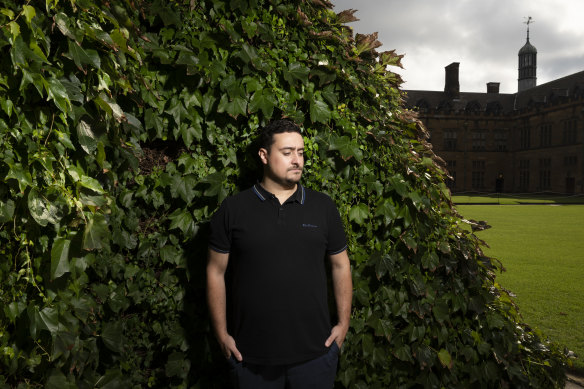This was published 3 months ago
‘Bouncers thought I was drunk’: What it’s like to live with narcolepsy
By Mary Ward
Dr Aaron Schokman remembers standing at the side of the road as a first-year science student, waiting for a gap in the cars to cross and continue walking to class. The lights unexpectedly turned red. A great outcome, he thought.
The next thing he knew, Schokman was face-first on the road. Everything had flown out of his hands, and he’d scraped his knees “pretty bad”.

Dr Aaron Schokman is a narcolepsy researcher and sufferer. Credit: Louise Kennerley
Later in the semester, he would regularly spend time with friends at the pub. A self-described jokester, he enjoyed making his friends laugh. But when he found something funny himself, his body would just collapse.
“Bouncers would kick me out of the pub because they thought I was drunk,” he recalled.
Schokman later learnt his spells – losing control of his body when experiencing a positive emotion – were called cataplexy, a symptom of narcolepsy, a rare and often misunderstood sleep disorder that can be a source of frustration and shame for sufferers.
The disorder, characterised by disruptions to the body’s sleep-wake cycle, is experienced by between 25 and 50 per 100,000 people.
It is commonly portrayed in film and TV as a condition that causes someone to instantly fall asleep, but a recently published research project by Schokman – whose diagnosis led him to swap aspirations to study medicine for a career in medical research at the University of Sydney – suggests symptoms are much more varied.
There are two types of narcolepsy: the less common type 1, an autoimmune condition in which sufferers lack a key protein that controls the sleep-wake cycle (Schokman’s narcolepsy developed after he caught swine flu on a European trip); and the more common type 2, which has no known cause and typically less severe symptoms, with sufferers more likely to experience general tiredness than what are colloquially known as “sleep attacks”.
The condition is diagnosed by a sleep clinic, through an observational sleep study in a lab.
Schokman interviewed 127 members of an Australian narcolepsy support group about their experiences, in a paper published in Sleep Medicine earlier this year.
Participants described the daily impact of narcolepsy on their lives.
“I keep a rubber band around my wrist ... just to flick, keep myself awake, drink cold water, wash my face, I’ll even bite a lemon, that extreme,” said one person with type 1.
People with narcolepsy who experienced cataplexy reported anxiety about moderating their emotions.
Another common theme was concerns about the stigma of their condition, from people who did not believe narcolepsy really existed and also employers who may be concerned about sufferers’ abilities or not understand the spectrum of the disorder’s severity.
“I’m not some tired piece of crap who can’t stay awake. I’m genuinely fighting something,” said one type 2 narcolepsy sufferer.
Standard treatment for the condition is a high dose of amphetamines and, for those who experience cataplexy, a high dose of antidepressants to keep the person awake and reduce emotional range.
“Internationally, there are six different medications [for narcolepsy], but in Australia we’ve had the same treatments since the 2000s,” said Schokman, who now personally imports medication.
Professor Robert Adams, medical director of Flinders University’s sleep health research institute, said a range of factors meant it was difficult to diagnose and find government funding for treatment for sleep disorders, particularly rare and debilitating ones.
“Patients may not recognise the symptoms, or they may face stigma, like how sleepiness is associated with laziness,” he said.
“Then there’s the problem with actually identifying the problem as a sleep disorder, rather than tiredness or caused by external causes, like shiftwork.”
Adams said the problem with funding dedicated medication for sleep disorders was largely that their effect was just to make patients “feel better”.
“And it is really only recently, probably across all of medicine, that we’ve recognised simply feeling better as a patient outcome.”
The Examine newsletter explains and analyses science with a rigorous focus on the evidence. Sign up to get it each week.